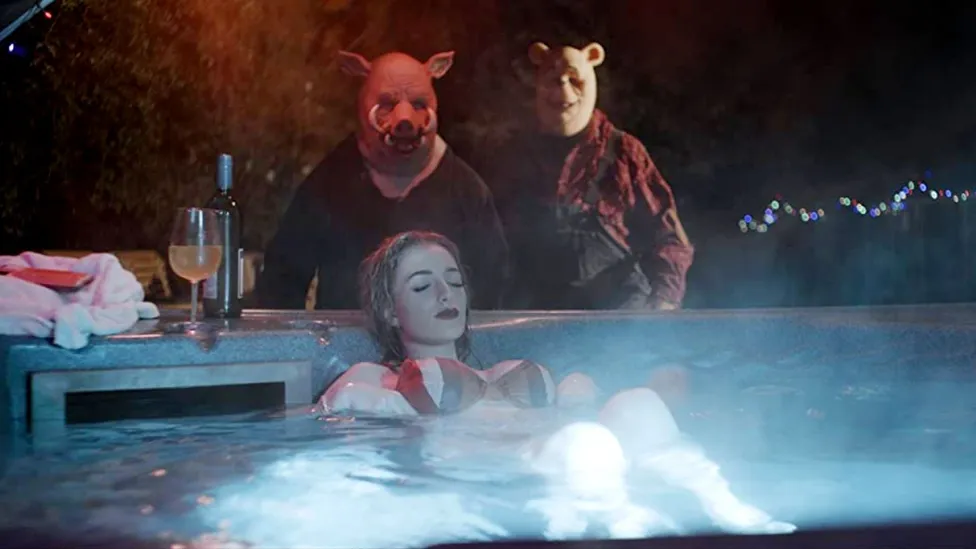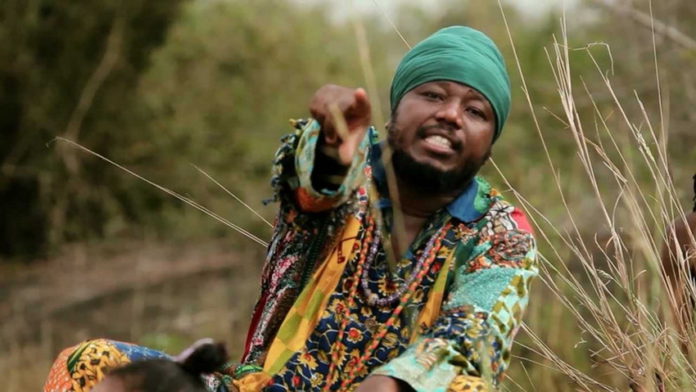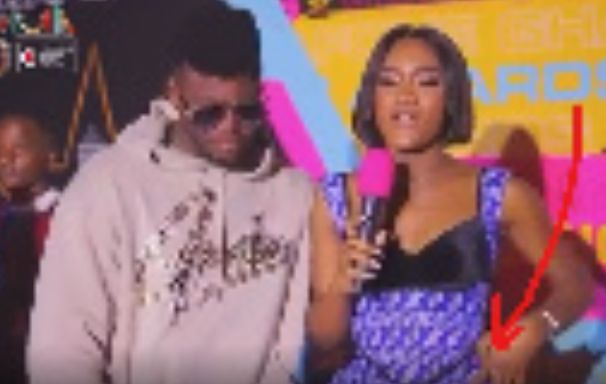The gory new Winnie the Pooh horror causing a storm

Each year, in many countries around the world, 1 January remains one of the most exciting days in the calendar for lawyers and creatives alike. It’s Public Domain Day, when the copyright expires for works published a certain duration ago – the US copyright limit is 95 years, while in the UK it is 70 years – and those works therefore lapse into the public domain. 2022’s Public Domain Day in the US brought with it a particularly tantalising prospect: AA Milne’s Winnie The Pooh was among the works that had reached their 95-year copyright limit, meaning that the butterball bear could henceforth be used and depicted by anyone – and in any way they wanted.
More like this:
– The return of slasher horror
– The power of the eerie in film
– The most disgusting films ever made
Within months, the culturally entrenched image of Winnie The Pooh as a kind, smiling, honey-bellied fellow had quite literally been savaged. On May 25, the poster for an upcoming slasher-horror film named Winnie The Pooh: Blood and Honey was released, and a new Pooh emerged: half-man, half-bear; axe-wielding, snarling, feral, terrifying. The image went viral across the internet, triggering a response that seemed to split into two distinct camps. One side seemed to laugh it off, while the other was outraged. Petitions against the film’s release were filed.

The film sees everyone’s favourite bear turned feral, and embarking on a killer spree (Credit: Alamy)
After only five months of Winnie The Pooh’s lapse into the public domain, a man had both made an entire horror film from the character, and begun that film’s release strategy. That man is UK filmmaker Rhys Frake-Waterfield, who until recently worked for an electricity supplier while making micro-budget horror films on the side. Now, on the back of his directorial debut, Waterfield is responsible for what may turn to be one of this year’s most profitable film releases. Originally intended as a streaming release with a single-day theatrical showing in the US, now, on the back of its poster and trailer’s unexpected online virality, the film is being rolled out in cinemas across the world. In Mexico, where the film received its global premiere on 29 January, the film went to number 4 at the box office in its first week, taking in a reported $700,000. (Waterfield hasn’t disclosed the film’s specific budget, though indicated in a recent interview with Variety that it was made on less than $100,000). Those are good omens for this week’s release in the US, where it is screening in more than 1,500 theatres.
The genesis of a bizarre idea
Alongside Scott Jeffrey, a frequent collaborator as well as the film’s producer, Waterfield had been “trying to come up with ideas that hadn’t been done before”, something “extremely different and strange”, he tells BBC Culture. “What fairytales and monsters are there that we can twist in a different direction? Or change something that was never a monster into a monster? That sounded really interesting and cool.”.
As soon as Waterfield realised that Pooh had lapsed into the public domain in the US, he began racking his brain for ideas.
Waterfield had also noticed a surfeit of over-serious horror films in the current landscape; elevated horror, like The Babadook or Men which deployed “metaphors” as their bogeymen – films that, as The Guardian’s AA Dowd wrote last year, “strive, loudly and unsubtly, to be about something scarier than a sharp knife or sharp fangs, something real and important”. Winnie the Pooh: Blood and Honey, on the other hand, strives to be nothing but a slasher film starring Winnie The Pooh and a couple of friends. The film, which is reliant on well-trodden slasher tropes throughout (think: an invincible villain on an unbending vendetta; attractive women in bikinis coming to an unfortunate end) won’t exactly move the genre forward, though it’s good, simple, bloody fun all the same.
Waterfield’s first issue: how to make Winnie The Pooh scary? “Then, I very quickly got the idea that the film’s main theme would be abandonment,” Waterfield says. Blood and Honey opens with a now-adult Christopher Robin returning to the Hundred Acre Wood, many years after departing it for college. There, he finds his once domesticated friends Winnie the Pooh and Piglet turned feral; scavenging for flesh, blood and drool hanging from their muzzles, ready to go on a killing spree, and ultimately wreak revenge upon Robin for abandoning them all those years ago.
There are these elements where we need to be careful not to encroach on Disney’s brand and their territory because that’s not the intention – Rhys Frake-Waterfield
“I likened it to a pet. If you’ve got a pet and they become super reliant on you and they love you, you give them food, you shelter them, their life’s set, they’re expecting that to continue forever. Then suddenly, if one day that stopped and they got left in the woods, they would become a very different animal. That’s what I wanted,” Waterfield explains.
With plenty of gore and guts throughout the film, and given the blatant distress for many on seeing these much-loved childhood characters turned savage, Waterfield resolved his first issue of how to make the beloved ursine terrifying. The second, more pressing, issue that loomed over him, though, was the finicky law and copyright surrounding Winnie The Pooh.
So far, only one of four of A A Milne’s Winnie the Pooh books has lapsed into the public domain, 1926’s Winnie-the-Pooh, meaning that not all of the characters are yet able to be depicted without legal repercussion. Tigger, most notably, does not appear in the Hundred Acre Wood universe until 1927’s The House at Pooh Corner, which is why you won’t see him in Blood and Honey. Certain aspects of Pooh are subject to trademark laws, too, including his red shirt, which Disney made iconic in their later depiction of the bear, and so remains their property; that item of clothing was therefore left out of Blood and Honey too. Thankfully, the multinational conglomerate has yet to be in contact, Waterfield says.

In this new incarnation, Winnie the Pooh wears a lumberjack shirt, bear mask and dishwasher gloves (Credit: Alamy)
“We weren’t allowed to have him say things like ‘oh bother’ either,” says Waterfield. “There are these elements where we need to be careful not to encroach on their brand and their territory because that’s not the intention. The intention isn’t just to steal their copyright and use it for our own purposes. It’s to go from something which is possible to use because it’s now publicly available, and just go off on an extreme tangent from that point and make this horrific alternative version to him.”
Now, Waterfield’s version of Pooh will be trademarked, too. A bear, filled with both guts and fluff, that could not be further from Disney’s version. Instead of a little red shirt, he wears a lumberjack shirt, a mask bought from eBay, and dishwasher gloves – a costume that was worn by Pooh actor Craig David Dowsett for 12 hour days during the film’s intensive 10 day shoot in early 2022.
I find it crazy that people can get themselves worked up to that extent over something they’re not forced to watch – Rhys Frake-Waterfield
Dowsett, a former engineer who turned to acting when he was furloughed from his job during the pandemic, is as new to film as Waterfield is. Even still, fans waited for him outside of his minibus in Mexico City when the film premiered there. He’s currently enjoying a week-long trip in LA, where the film had its US premiere yesterday, before heading back to England to promote the film’s 10 March release. In early June, he will travel to Japan. “When they asked me to play Winnie The Pooh I said, what?! But now having seen the film, I love it,” Dowsett tells BBC Culture in his strong Essex accent – a voice that is seldom heard throughout the film, save for the odd grunt. “We wanted to mostly keep Pooh silent so that he’d appear more sinister,” Waterfield explains. Dowsett’s physicality was core to his performance – he moves with a kind of hulking balefulness that bears an obvious resemblance to Halloween’s Michael Myers.
It seems any outrage against the film has helped swell its success. A sequel has already been greenlit, while Waterfield is at work on numerous other childhood-ruining concepts, including Bambi and Peter Pan based horror films. “I have a notepad of 20 other ideas that I think would be amazing concepts. I was looking at things like Mr Blobby, Teletubbies, and The Powerpuff Girls, but most of them are still well within copyright.”
In the meantime, more horrifying than anything in Winnie the Pooh: Blood and Honey is the fact that Waterfield is receiving near-daily death threats for his first film. “We’ve also had people threaten to call the police on us,” he says, adding: “I find it crazy that people can get themselves worked up to that extent over something they’re not forced to watch. When I was making the film I was laughing.”
Winnie the Pooh: Blood and Honey is released in US cinemas today, and will be released in UK cinemas on 10 March
Love film and TV? Join BBC Culture Film and TV Club on Facebook, a community for cinephiles all over the world.
If you would like to comment on this story or anything else you have seen on BBC Culture, head over to our Facebook page or message us on Twitter.
And if you liked this story, sign up for the weekly bbc.com features newsletter, called The Essential List. A handpicked selection of stories from BBC Future, Culture, Worklife and Travel, delivered to your inbox every Friday.





